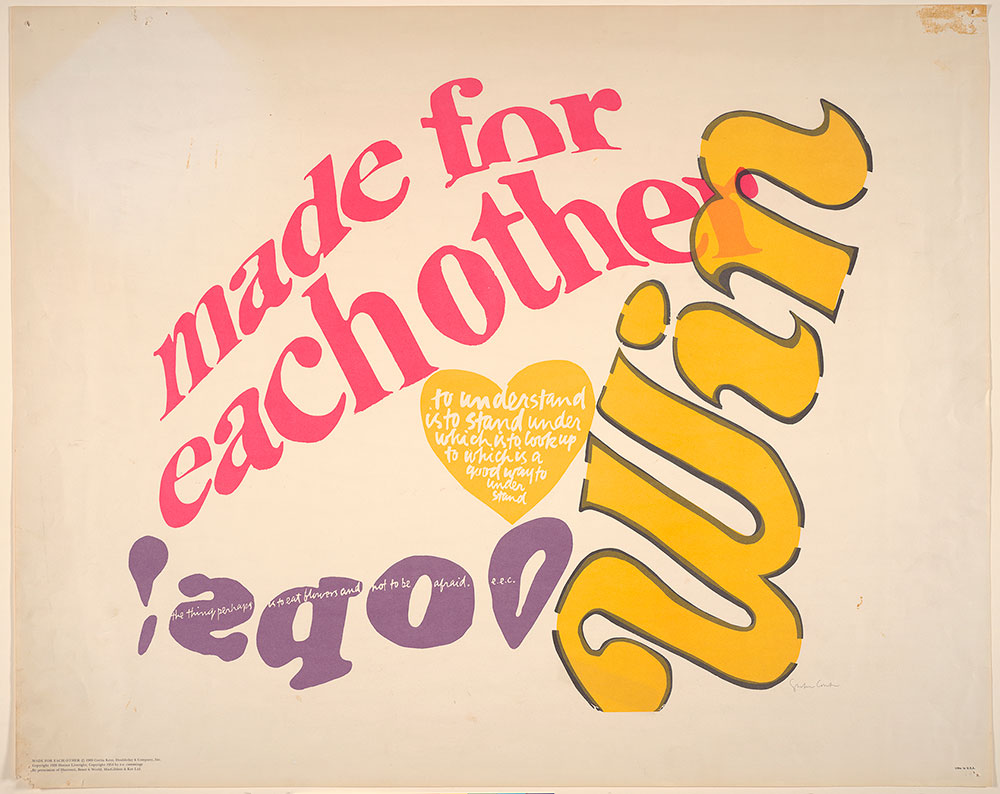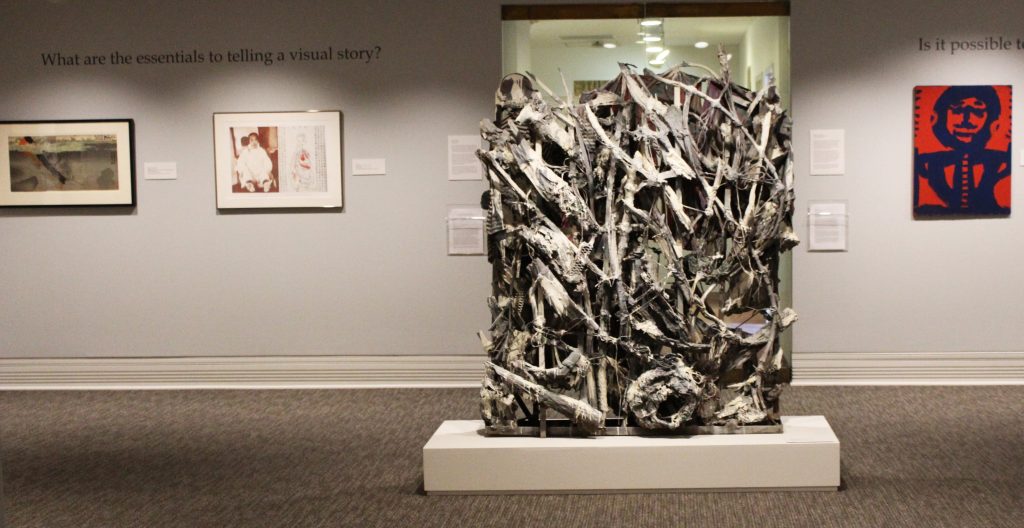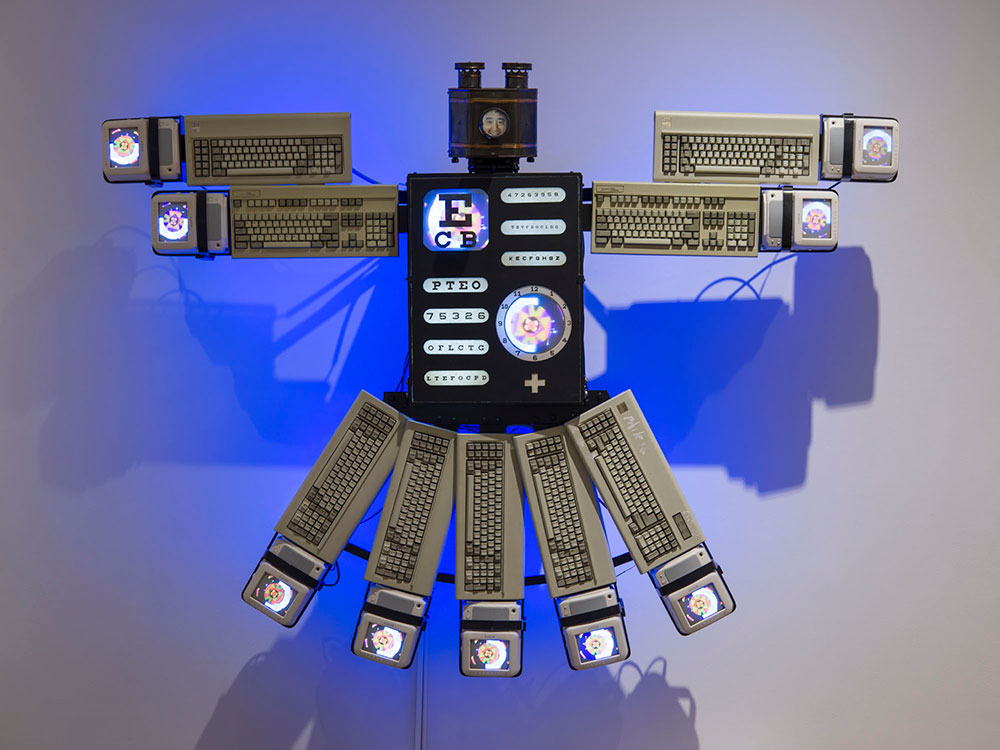
By Jenny Marvel, Head of K12 and Community Programs, Ackland Art Museum
Genius is looking at things in an unhabitual way.
Work in areas where you are unsure, in places you’ve not been before.
Corita Kent[1]
I love the work that I do in the Ackland’s education department, especially learning about specific works of art, artists, and art-making techniques and then finding ways to share this information with others—whether with our volunteer docents, K12 students and teachers, or community groups visiting the Museum. Often, I find inspiration from one or two pieces within an exhibition, and our current show, Birthday Presents, is no exception! This exhibition showcases major works of art that have been donated or promised by generous friends and supporters, specifically honoring the Museum’s sixtieth anniversary.
Over the past month, I’ve been reading about an artist that I did not know much about, Sister Corita Kent (American, 1918 – 1986). Corita was an artist, educator, and advocate for social justice. At eighteen, she entered the Immaculate Heart of Mary religious order, eventually teaching in the art department at Immaculate Heart College in Los Angeles for twenty-seven years (1941 – 1968). Often including advertising images, song lyrics, and literature, her prints of the 1960s reflect the Pop Art style.
Although I enjoy her art, I am most inspired by Corita’s teaching philosophy on how to see and experience the world. After reading Learning by Heart: Teachings to Free the Creative Spirit, which details the teaching methods developed by Corita Kent and her mentor, Sister Magdalen Mary at Immaculate Heart College in the 1950s and 60s, I found many similarities to my own personal life/work philosophy. I was also pleasantly surprised that many of her close looking and creative thinking “assignments” for her students echo gallery experiences that we currently use in the Museum!
She encouraged students to slow down, make close and careful observations of the world around them, and draw. She had them use a viewfinder, a small handheld tool with a square cut out, to see their environment through a new perspective—for she wanted the students to develop what she termed their “seeing muscles.” According to Corita, using a viewfinder “helps us take things out of context, allows us to see for the sake of seeing, and enhances our quick-looking and decision-making skills…You can then view life without being distracted by content. You can make visual decisions—in fact, they are made for you.”[2]
Now it’s time to put your “seeing muscles” to work! Try making your own viewfinder by cutting a rectangular hole out of a heavy piece of paper or cardboard. Hold the viewfinder in one hand and look closely at the details of an object (a shoe, a tree, a car, etc.). What details become more noticeable with your viewfinder? This tool, like a magnifying glass, can be used to see individual parts of a whole object. Go and explore the natural world or use inside at home or at the Ackland Art Museum!
As I wrap up this post, I wanted to leave you with another looking assignment found in Learning by Heart. This one encourages the viewer to spend time looking closely and making detailed observation notes. Good luck and enjoy!
Looking Assignment: Nothing is the Same
When we give names to things, we often assume that everything that goes by that name is alike.
Take something in nature—two dandelions—and look at them for five minutes. List how they are different from each other. Take two leaves from the same tree and do the same thing. Take two peas from the same pod and do the same thing. Nothing is the same. No thing is the same. Everything is itself and one of a kind.
After doing this for a week, look back at these pairs of things again and make a new list. You will find more differences because you have been exercising your powers of observation.
Jenny Marvel, the Head of School and Community Programs at the Ackland Art Museum, UNC-Chapel Hill, earned a BA in Art History at the University of North Texas (1998) and an MA in Historical Administration from Eastern Illinois University in 2001. Prior to her employment at the Ackland Art Museum, Jenny worked in a variety of education departments including The Children’s Museum of Indianapolis, The Museum of Flight (Seattle, WA), and the Dallas Museum of Art. Jenny’s experience includes developing, implementing, and assessing school and community tours, online resource materials for students and teachers, and cross-cultural and interdisciplinary teacher workshops.
[1] Kent, Corita and Jan Steward. Learning by Heart: Teachings to Free the Creative Spirit. (New York: Allworth Press, 2008), 21.
[2] Ibid, 26.
Corita Kent, American, 1918–1986, Made for Each Other,1969, offset lithograph reproduction of a 1967 screenprint. Ackland Art Museum, University of North Carolina at Chapel Hill. Gift of William A. Koehnline in honor of the Museum’s 60th Anniversary, 2018.27.


